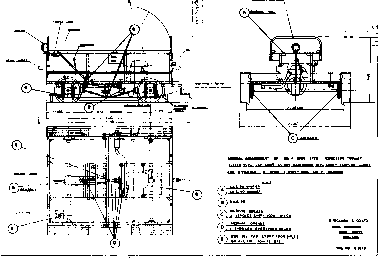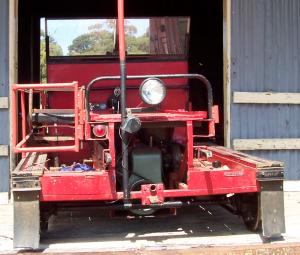|
|
|

|
Preservation and Restoration of NSW Railway Track Vehicles |
|
NSWGR Trikes |

|
©Copyright NSWGR Trikes 2016 |
|
Trikes and Trolleys A short history of track vehicles on the NSWGR
by Greg Lee |
|
Chapter 8 The Wickhams
The American built Fairmonts had been introduced in the 1940s, and had proved quite successful. However, for some reason, when further gang cars were required, the NSWGR administration decided to try a completely different type of vehicle, manufactured by an English company. This vehicle was known as the Wickham, and was manufactured by D. Wickham & Co. Ltd., of Ware, Hertfordshire., England. It was classified by that company as their No. 4 open type gang trolley.
It is known that a prototype of the No. 4 car was received in NSW by July 1954, for evaluation purposes, with the intention of standardising on a design. The prototype must have proved satisfactory, as a considerable number of the No. 4 cars were subsequently purchased. While the exact number of cars ultimately employed is not certain, it is known to be at least one hundred. The first of these cars entered service in 1955. These cars were built in England, and imported complete. A later batch of cars was assembled in Australia (possibly in about 1959) by Marine and Industrial Power Pty. Ltd., of Neutral Bay, Sydney, from parts imported from Wickham & Co.
The English built cars may be distinguished from the Australian built, by the type of 1-1/4" square tube used for the all welded frame. The Australian tube has rounded external corners of about 5/16" radius. The English tube is nearly perfectly square, with only a very small radius curve applied to the external corners.
Wickhams were powered by a J.A. Prestwich (JAP), 600 cc, four stroke, single cylinder, air cooled petrol engine, rated at 6-10 H.P Power from the engine was passed through a standard automotive type clutch, and then by cardan shaft to a two speed, two directional gearbox. The axle boxes were made of cast aluminium, and fitted with a single roller bearing. The brake shoes were made of cast iron, and applied to the flanges of the wheels. The spoked wheels were of 14" diameter, and made from pressed steel. See Figure 1.
These JAP engines were of the dry sump type, with oil being circulated by a scavenger pump. The crank case and cowlings were made from aluminium alloy. There was no crankshaft as such, with the crankpin being located between two internal fly wheels, from whose centres spindles protruded to form the main journals. The big end bearing was a caged roller bearing, and the main bearings were ball bearings. Ignition was provided by a Wipac impulse magneto. The engine was started with a crank handle. Starting was usually easy, with only an upward half turn being required.
The gearbox incorporated ball bearings, helical cut and bevel gears, with gear changes’ being affected by dog clutches.
Wickhams were supplied to many fettling gangs in NSW, and were generally well received by the men who used them. They were permitted to carry up to six men, and travel at speeds up to 30 MPH (48 kph). They were capable of speeds in excess of 60 kph. They were a medium weight car of 370 kg. They gave generally faithful service for in excess of twenty years. By the mid 1970s, the JAP engines were becoming in need of reconditioning, and some parts for the engines were becoming unobtainable. In particular, the rollers for the big end bearings, and exhaust valves could not be obtained.
In 1977 the Motor Shop at Chullora Workshops commenced a programme of re-powering the cars with Wisconsin engines, having electric start. See Figure 2.
Many Wickhams were so re-powered, with the JAP engines released being used to provide parts for the remaining JAP powered Wickhams, which were then confined to Tamworth and Grafton Divisions only. Wickhams were also re-powered by the Division Trike Mechanics, with the last JAP engines being replaced in the late 1980s or early 1990s.
The Wickham cars were not as robust as their Fairmont counterparts, with several areas of particular weakness being apparent. The wheels were not of sufficient strength, and were prone to cracking through the spokes. The single plain roller axle box bearings were occasionally subject to failure, which if not promptly detected would result in the axle destroying the aluminium axle box. The brake hangers were particularly weak, and as early as 1961 it was reported that they were wearing badly and required replacement. The gearboxes suffered from wear to the dog clutches, and occasional bearing failure.
In comparison, Fairmonts had extremely robust wheels, and substantial double tapered roller axle bearings. Their brake gear was superior and their gearboxes were also more robust, but not being two directional, were of simpler design.
Wickhams however had two distinct advantages over Fairmonts. One being a superior ignition system with consequent better reliability, and the other being the two directional gearbox, which meant the engine did not have to be restarted to change the direction of travel.
Wickhams were similar in size and weight to the MT 14 Fairmonts, which were purchased at about the same time. In general the Wickhams remained in service longer than the MT 14 Fairmonts, which is undoubtedly due to the fact that the Wickhams were re-powered, while the Fairmonts were not. Re-powering the Fairmonts with a more modern engine was effectively impossible since the Fairmonts required an engine which would run in both directions.
Although use of track vehicles in NSW gradually declined from the 1960s with the introduction of road transport, many Wickhams remained in service until the 1980s, with last of them giving way to Hyrail road-rail vehicles in about 1995. They thus had lives of up to forty years, which is probably far longer than their manufacturers anticipated, and is testimony to their success, despite their mechanical shortcomings.
Acknowledgments Alan Robinson, Bathurst. Errol Hall, Tregeagle (Lismore).
Figure 1. General arrangement of the Wickham gang cars as manufactured. Drawing dated 26/10/54.
Figure 2. Wickham gang car as repowered with a Wisconsin engine, at the Motor Shop, Chullora Workshops, 1977.
|
|
© Greg Lee, 1992 - 1999 |

